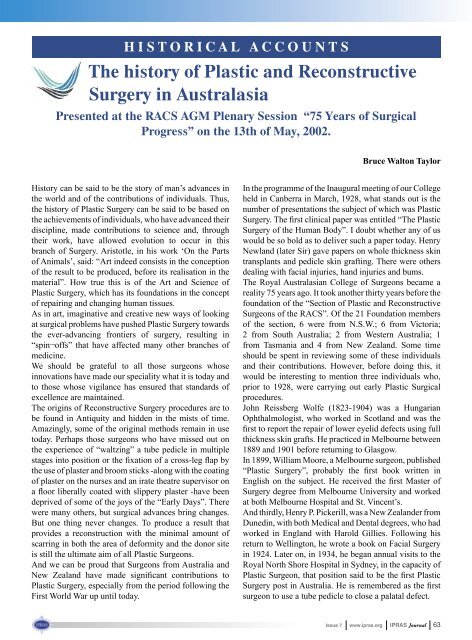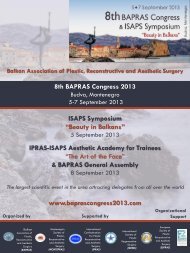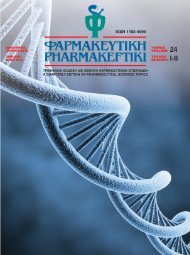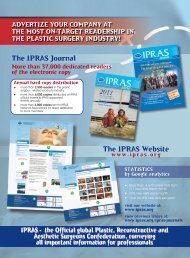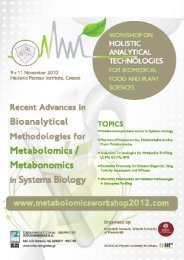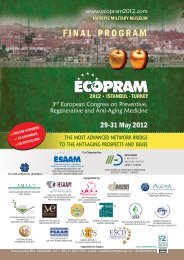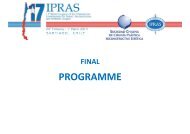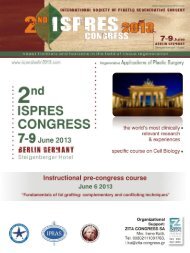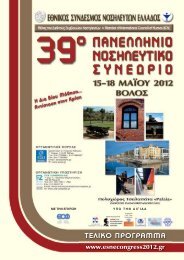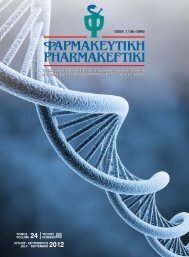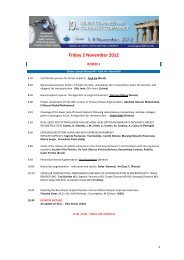IPRAS
IPRAS
IPRAS
Create successful ePaper yourself
Turn your PDF publications into a flip-book with our unique Google optimized e-Paper software.
H I S T O R I C A L A C C O U N T SThe history of Plastic and ReconstructiveSurgery in AustralasiaPresented at the RACS AGM Plenary Session “75 Years of SurgicalProgress” on the 13th of May, 2002.Bruce Walton TaylorHistory can be said to be the story of man’s advances inthe world and of the contributions of individuals. Thus,the history of Plastic Surgery can be said to be based onthe achievements of individuals, who have advanced theirdiscipline, made contributions to science and, throughtheir work, have allowed evolution to occur in thisbranch of Surgery. Aristotle, in his work ‘On the Partsof Animals’, said: “Art indeed consists in the conceptionof the result to be produced, before its realisation in thematerial”. How true this is of the Art and Science ofPlastic Surgery, which has its foundations in the conceptof repairing and changing human tissues.As in art, imaginative and creative new ways of lookingat surgical problems have pushed Plastic Surgery towardsthe ever-advancing frontiers of surgery, resulting in“spin¬offs” that have affected many other branches ofmedicine.We should be grateful to all those surgeons whoseinnovations have made our speciality what it is today andto those whose vigilance has ensured that standards ofexcellence are maintained.The origins of Reconstructive Surgery procedures are tobe found in Antiquity and hidden in the mists of time.Amazingly, some of the original methods remain in usetoday. Perhaps those surgeons who have missed out onthe experience of “waltzing” a tube pedicle in multiplestages into position or the fixation of a cross-leg flap bythe use of plaster and broom sticks -along with the coatingof plaster on the nurses and an irate theatre supervisor ona floor liberally coated with slippery plaster -have beendeprived of some of the joys of the “Early Days”. Therewere many others, but surgical advances bring changes.But one thing never changes. To produce a result thatprovides a reconstruction with the minimal amount ofscarring in both the area of deformity and the donor siteis still the ultimate aim of all Plastic Surgeons.And we can be proud that Surgeons from Australia andNew Zealand have made significant contributions toPlastic Surgery, especially from the period following theFirst World War up until today.In the programme of the Inaugural meeting of our Collegeheld in Canberra in March, 1928, what stands out is thenumber of presentations the subject of which was PlasticSurgery. The first clinical paper was entitled “The PlasticSurgery of the Human Body”. I doubt whether any of uswould be so bold as to deliver such a paper today. HenryNewland (later Sir) gave papers on whole thickness skintransplants and pedicle skin grafting. There were othersdealing with facial injuries, hand injuries and bums.The Royal Australasian College of Surgeons became areality 75 years ago. It took another thirty years before thefoundation of the “Section of Plastic and ReconstructiveSurgeons of the RACS”. Of the 21 Foundation membersof the section, 6 were from N.S.W.; 6 from Victoria;2 from South Australia; 2 from Western Australia; 1from Tasmania and 4 from New Zealand. Some timeshould be spent in reviewing some of these individualsand their contributions. However, before doing this, itwould be interesting to mention three individuals who,prior to 1928, were carrying out early Plastic Surgicalprocedures.John Reissberg Wolfe (1823-1904) was a HungarianOphthalmologist, who worked in Scotland and was thefirst to report the repair of lower eyelid defects using fullthickness skin grafts. He practiced in Melbourne between1889 and 1901 before returning to Glasgow.In 1899, William Moore, a Melbourne surgeon, published“Plastic Surgery”, probably the first book written inEnglish on the subject. He received the first Master ofSurgery degree from Melbourne University and workedat both Melbourne Hospital and St. Vincent’s.And thirdly, Henry P. Pickerill, was a New Zealander fromDunedin, with both Medical and Dental degrees, who hadworked in England with Harold Gillies. Following hisreturn to Wellington, he wrote a book on Facial Surgeryin 1924. Later on, in 1934, he began annual visits to theRoyal North Shore Hospital in Sydney, in the capacity ofPlastic Surgeon, that position said to be the first PlasticSurgery post in Australia. He is remembered as the firstsurgeon to use a tube pedicle to close a palatal defect.Issue 7 www.ipras.org <strong>IPRAS</strong> Journal 63


